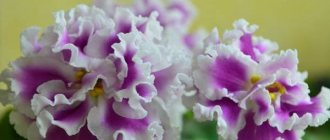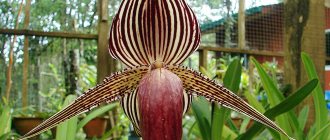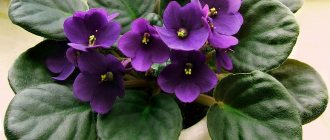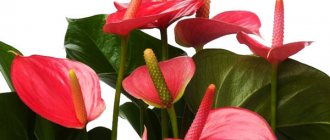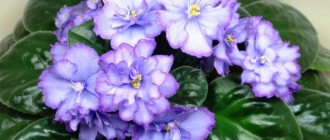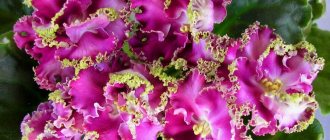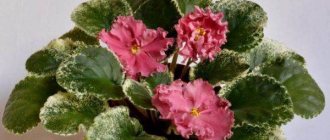Violet Lunar Lily White (J. Dates), or Lunar white lily
Photo and description
Semi-mini socket . The diameter reaches 15 cm , but most often the bushes are much smaller.
The violet is very compact , the leaves lie in even rows, tightly located next to each other. As a result, overhead watering is quite difficult.
The flowers are shaped like a spider. The color is pure white , without additional shades. The petals are elongated, thin, wavy, really reminiscent of spider legs that cover the ball.
The upper part of the flower resembles the Latin letter V, and the lower part M. Each petal is slightly bent inward towards the center.
The variety is considered one of the most unique. Valued by collectors for the unusual shape of the flowers, which is not repeated anywhere else. Despite the small rosette, the diameter of the flower reaches 4 cm.
Flowering is long-lasting, abundant , and almost always produces a lush head.
Among the flowers there are no larger or smaller ones, they are all standard. They bloom almost simultaneously and remain fresh for a long time. As a result , a beautiful bouquet is formed that can cover the rosette almost completely.
The peduncles are tall ; each of them can form from three to eight peduncles. It seems that the bouquet is floating above the rosette like a lush cloud. While some flower stalks are falling off, others are already crawling out.
Flowering is long-lasting but rare . The breaks between flowering are quite long, at least three months.
This variety attracts with its uniqueness . But there are no problems with leaving. It grows well, develops quickly , and blooms already in the eighth or ninth month after planting the baby.
All children develop slowly but steadily and bloom together. A full rosette is often completely covered with flowers.
Gives the first flowering after two full rows of leaves are formed. The rapid growth of the starter begins only after the root system has fully developed. To speed up development, the violet pot is placed closer to the light or artificial lighting is provided for 12-14 hours.
any sports , no variegation, no markings.
Landing rules
Theoretically, the Golden Lily violet, like other varieties, can be replanted throughout the year. However, the best time is the spring months, when the plant emerges from a short period of dormancy.
As a rule, for propagation it is enough to have several healthy, formed leaves with cuttings about 4 cm long or a baby separated from the main bush. Violet leaves are placed in a glass of water until roots appear. Then they are planted in a pot filled with soil.
Containers for growing Golden Lily violets are chosen to be small. Optimally, their diameter should be 1.5-2 times less than the expected diameter of the outlet. For the variety described in the article it is 17-20 cm.
Caring for a plant at home
Violets are grown in a pot with a diameter of six or seven centimeters. The socket is placed in a well-lit place. The longer the daylight hours, the greater the chance of waiting for flowering.
It is also very important to monitor the humidity of the earthen ball . Excessive moisture and prolonged lack of moisture can lead to disease or death of the plant.
Also, in this situation, the lower leaves may turn yellow or die completely.
Proper watering and fertilizing
This variety feels great on wick watering. In such conditions, it does not expand in width and remains compact.
But it is worth considering that violet is sensitive to overfilling and underfilling . It not only loses its decorative appearance, but may also die.
Plant feeding occurs according to standard schemes.
Important! During the period of growing the rosette, nitrogen is added to the soil, and after the appearance of flower stalks, it is fed with phosphorus and potassium.
Lighting and temperature
Saintpaulia Lunar Lily White prefers long-lasting and good light. During the flowering period, violets must be provided with 12-14 hours of daylight . If necessary, arrange lighting.
If there is insufficient lighting, Lunar Lily White should be supplemented with additional lighting.
The room temperature should be within +20°C . The plant does not go into sports from high temperatures, but in cool conditions it will bloom longer.
Direct sunlight and high temperatures are the most destructive factors for violets. We should not forget about this.
Air humidity
Humidity is one of the most important factors when growing violets. Humidity levels should be between 50 and 60%.
If the heating is on and it is too dry, you can spray water from a spray bottle or place a bowl of water near a pot of violets.
Attention! It is very important to prevent moisture from entering the growing point.
Soil composition
The soil should be light, breathable and retain moisture well.
For this purpose, you can purchase special mixtures or make them yourself.
You can add to purchased mixtures:
- coconut fiber;
- crushed coal;
- pieces of sphagnum moss.
The mixture should be loose, light and airy.
Pruning and hygiene
Immediately after the end of the flowering period, it is necessary to replant the plant. The bush is removed from the pot, the soil is shaken off and planted in fresh soil. After three months, the plant should produce new blooms.
This is one of the main secrets of growing this variety.
Reproduction methods
Violet propagates using leaf cuttings. It is accepted well, takes root quickly and produces a sufficient number of children.
Leaf cuttings.
Right away, young children develop very slowly. But after the root system fills the pot, the violet quickly grows foliage and produces flower stalks.
Transplant rules, rejuvenation
Saintpaulia is replanted every time after flowering.
If the trunk of the plant is too high and the rosette has lost its attractive appearance, then the top can be cut off, rooted and planted again in fresh soil. This procedure is called rejuvenation.
Description of the violet variety Peruvian lily
Before characterizing this plant, it is worth saying that the flower is also known under another name - alstroemeria. In common parlance there are other names for the plant:
- "Inca lily" or "lily of the Incas".
- "parrot lily"
- "Peruvian lily"
All plants included in this family are considered multi-year herbaceous crops. The root system is very powerful. The stems are erect and grow quickly. The foliage of this plant is unusual compared to other varieties of herbaceous crops. They have the property of resupination. This means that the plant can turn around its axis.
It turns out that the plant twists its foliage so that the top of the leaf changes place with the bottom of the leaf. The shape of the Peruvian lily flowers resembles something between a lily and an orchid. This has spread false information that sellers tell plant buyers. Some people mistakenly think that this plant is a selection species from parent plants - lilies and orchids. It is not true! This plant, like the lily, has an inflorescence with six pointed petals. The color palette is varied.
Usually these are yellow, pink, red colors. Most often, petals of the same shade contain a variety of patterns, for example, stripes and lines. The flowering process occurs at the end of the spring season or at the beginning of the summer season. Insects take over pollinating plants or the winds do it. In its native land, pollination of this plant is carried out by small representatives of birds - hummingbirds. A fruit is formed on the flower, a box with planting material, namely seeds, small in size and round in shape. It is surprising that the fruit explodes on its own, and its planting material, namely the seeds, flies several meters away from the plant.
When growing wild, this plant grows in conditions favorable to it, namely in warm temperatures. However, there are varieties that grow above water, such as the sea. For all the time that it has been grown in Europe, a huge variety of varieties have been obtained, which are grown in personal greenhouses, gardens and collections.
Features of flowering, growth and reproduction
Violet is not capricious; it develops well at home. To grow a full-fledged plant with bouquet flowering it will take from 10 to 12 months.
It does not go into sports; it is propagated by cuttings.
Prefers good lighting, long daylight hours, but does not tolerate extreme heat and direct sunlight.
The peduncles are long and tall, but the flowers hold well. It seems that the bouquet is floating above the rosette. Almost always blooms with a cap.
Lunar Lily White has long but strong flower stalks.
It blooms for a long time, one bud lasts about three weeks . Constantly produces new flower stalks.
Diseases and pests
Most diseases of Golden Lily violets are associated with improper care and disturbance of the indoor microclimate. The most dangerous disease is considered to be vascular bacteriosis. The disease occurs at elevated temperatures in the room, causing disruption of the plant's nutrition and rotting of the leaves. To avoid problems, they try to replant violets every spring, use nitrogenous fertilizers with caution, regularly ventilate the room in the summer, and water them several times with a solution of the drug Previkur.
Reviews
Elena, Moscow. “The rosette is developing well, but growth is very slow. But when it starts to grow sharply, it straight out of the pot. He begins to cut leaves with the edges of the container. To prevent damage, I melt the edges of the pot with a candle before planting.”
Anna, Voronezh. “I fought with this variety for a very long time. I had two options, white and pink. In the end, I went for the fourth pass, waited for the first flower stalks and successfully removed the plant. Now I can live in peace: I grew this variety.”
